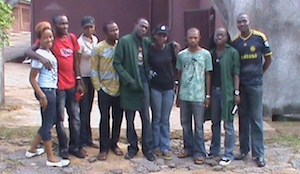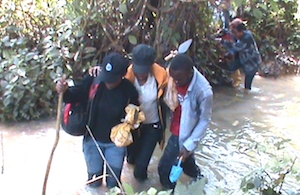|
Limestone hills are biodiversity hotspots known to habour many endemic species. The limestone hills in Mfamosing, Cross River State, southeastern Nigeria are one of the few limestone hill areas in Nigeria and in West Africa. The hills are seriously threatened by commercial exploitation for cement and other industrial raw materials (e.g. poultry feeds, toothpaste, etc.) by both local and multinational cement companies. The biota of these hills is not known, and many species stand at risk of disappearing if the hills are destroyed.
Studies on the land mollusc species in the limestone hills in Mfamosing were carried out by myself with the assistance of seven students from the Department of Animal and Environmental Biology, and two students from the Department of Soil Science, University of Benin, Benin City, Nigeria. We also had the assistance of three local guards in our team (figure 1).
We sampled six limestone hills in total and collected about 66 species and over 1500 specimens in 14 families of land molluscs. Most of the species were rare with restricted range sizes and of great conservation interest giving the fact that the limestone hills are currently being exploited for limestone by local quarry companies. One of the hills visited in 2009 has been mined almost to ground level. It is also very interesting to know that some of the species recorded in these hills are new species (to be described in the Journal of Conchology).
Some of the problems encountered include the long travelling time (28 hours by road), difficult terrain that entails crossing deep, narrow streams (figure 2) and insect bites and stings (especially sand flies and bees). We also encountered two snakes (cobras) while crossing the swamp to one of the limestone hills. It was a very interesting field experience for all of us and we are grateful to the Conchological Society of Great Britain and Ireland for their financial assistance that enabled us to cover the travel expenses. Figure 3 shows the degraded limestone hills. Figure 4 shows some of the snails collected from the limestone hills. |
figure 1: Participants in the field work. From left to right: Ngozi Azubike, Gerald Okonkwo, Itohan Amadasun, Ekene Sidney Ogboli, Emediong Ita, Lydia Eguavoen, Theophilus Ogbeifun, Ogheneovo Dibo and Samuel Ebeye. (Photo: Chris Oke)
figure 2: Lydia, Itohan and Gerald crossing a fast flowing stream to one of the limestone hills. (Photo: Chris Oke) figure 3: Degraded limestone hill. (Photo: Chris Oke)
figure 4: Some of the snail species collected during the survey. (Photo: Chris Oke) |
Survey of land snail diversity in some threatened limestone hills in Mfamosing, Cross River State, Nigeria
Issue
28
Page
12



